Discrimination and Social Exclusion for Vulnerable Groups in Afghanistan
VerifiedAdded on 2023/06/10
|13
|4062
|376
AI Summary
This paper discusses the impact of social exclusion and discrimination on vulnerable groups in Afghanistan, including women, internally displaced persons and returnees, people living with disabilities, children, kuchi nomads, the elderly and ex-soldiers. It highlights the challenges faced by these groups and suggests ways to address the negative impact on their health.
Contribute Materials
Your contribution can guide someone’s learning journey. Share your
documents today.
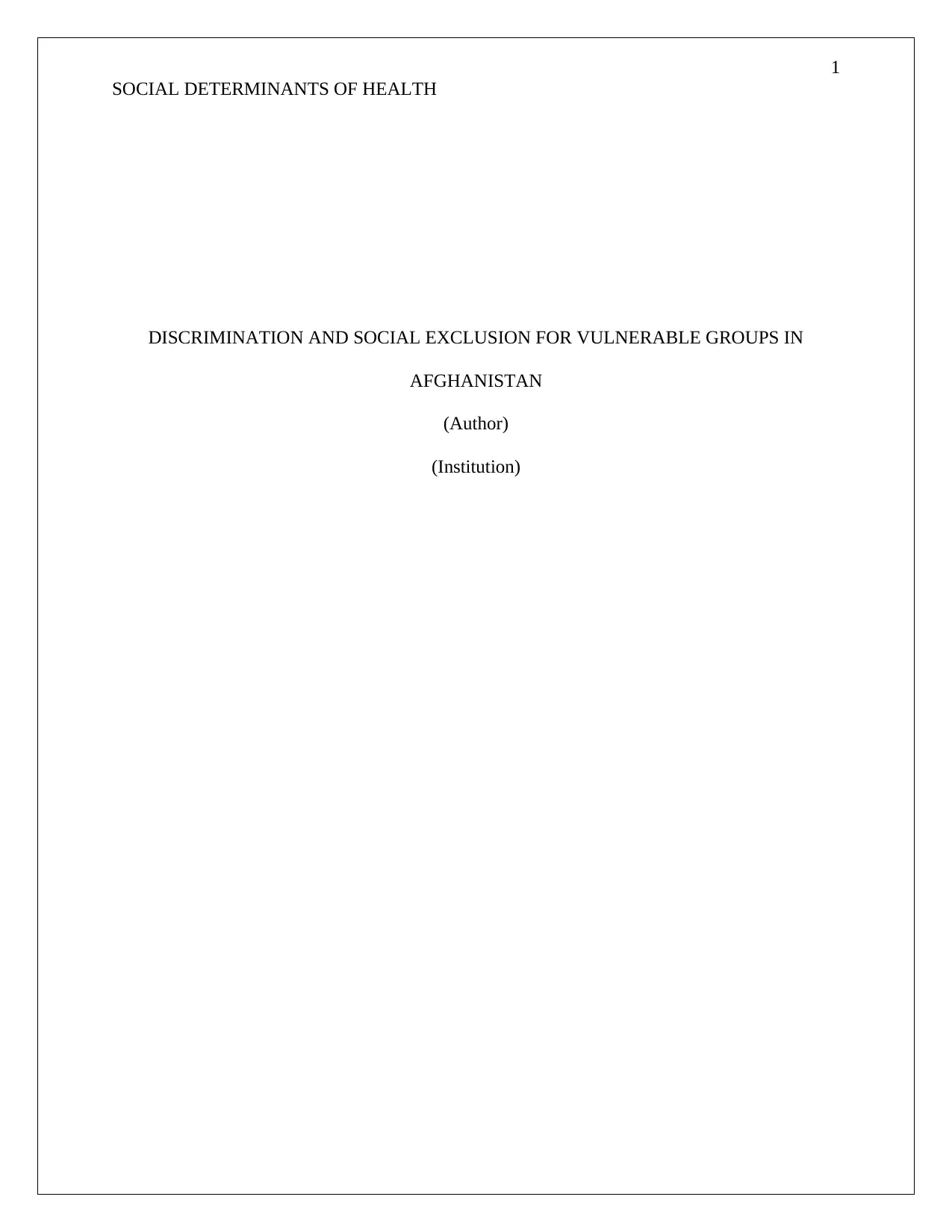
1
SOCIAL DETERMINANTS OF HEALTH
DISCRIMINATION AND SOCIAL EXCLUSION FOR VULNERABLE GROUPS IN
AFGHANISTAN
(Author)
(Institution)
SOCIAL DETERMINANTS OF HEALTH
DISCRIMINATION AND SOCIAL EXCLUSION FOR VULNERABLE GROUPS IN
AFGHANISTAN
(Author)
(Institution)
Secure Best Marks with AI Grader
Need help grading? Try our AI Grader for instant feedback on your assignments.
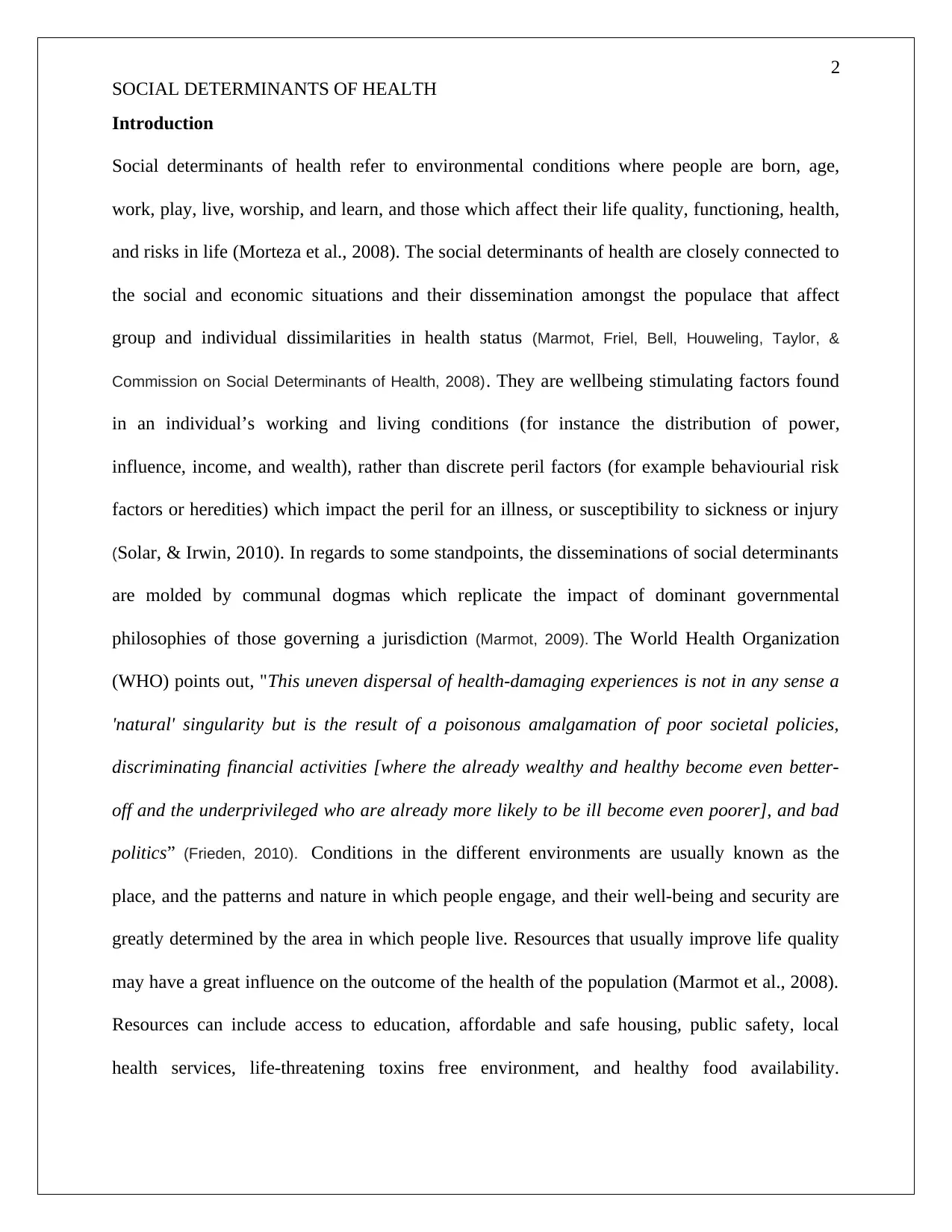
2
SOCIAL DETERMINANTS OF HEALTH
Introduction
Social determinants of health refer to environmental conditions where people are born, age,
work, play, live, worship, and learn, and those which affect their life quality, functioning, health,
and risks in life (Morteza et al., 2008). The social determinants of health are closely connected to
the social and economic situations and their dissemination amongst the populace that affect
group and individual dissimilarities in health status (Marmot, Friel, Bell, Houweling, Taylor, &
Commission on Social Determinants of Health, 2008). They are wellbeing stimulating factors found
in an individual’s working and living conditions (for instance the distribution of power,
influence, income, and wealth), rather than discrete peril factors (for example behaviourial risk
factors or heredities) which impact the peril for an illness, or susceptibility to sickness or injury
(Solar, & Irwin, 2010). In regards to some standpoints, the disseminations of social determinants
are molded by communal dogmas which replicate the impact of dominant governmental
philosophies of those governing a jurisdiction (Marmot, 2009). The World Health Organization
(WHO) points out, "This uneven dispersal of health-damaging experiences is not in any sense a
'natural' singularity but is the result of a poisonous amalgamation of poor societal policies,
discriminating financial activities [where the already wealthy and healthy become even better-
off and the underprivileged who are already more likely to be ill become even poorer], and bad
politics” (Frieden, 2010). Conditions in the different environments are usually known as the
place, and the patterns and nature in which people engage, and their well-being and security are
greatly determined by the area in which people live. Resources that usually improve life quality
may have a great influence on the outcome of the health of the population (Marmot et al., 2008).
Resources can include access to education, affordable and safe housing, public safety, local
health services, life-threatening toxins free environment, and healthy food availability.
SOCIAL DETERMINANTS OF HEALTH
Introduction
Social determinants of health refer to environmental conditions where people are born, age,
work, play, live, worship, and learn, and those which affect their life quality, functioning, health,
and risks in life (Morteza et al., 2008). The social determinants of health are closely connected to
the social and economic situations and their dissemination amongst the populace that affect
group and individual dissimilarities in health status (Marmot, Friel, Bell, Houweling, Taylor, &
Commission on Social Determinants of Health, 2008). They are wellbeing stimulating factors found
in an individual’s working and living conditions (for instance the distribution of power,
influence, income, and wealth), rather than discrete peril factors (for example behaviourial risk
factors or heredities) which impact the peril for an illness, or susceptibility to sickness or injury
(Solar, & Irwin, 2010). In regards to some standpoints, the disseminations of social determinants
are molded by communal dogmas which replicate the impact of dominant governmental
philosophies of those governing a jurisdiction (Marmot, 2009). The World Health Organization
(WHO) points out, "This uneven dispersal of health-damaging experiences is not in any sense a
'natural' singularity but is the result of a poisonous amalgamation of poor societal policies,
discriminating financial activities [where the already wealthy and healthy become even better-
off and the underprivileged who are already more likely to be ill become even poorer], and bad
politics” (Frieden, 2010). Conditions in the different environments are usually known as the
place, and the patterns and nature in which people engage, and their well-being and security are
greatly determined by the area in which people live. Resources that usually improve life quality
may have a great influence on the outcome of the health of the population (Marmot et al., 2008).
Resources can include access to education, affordable and safe housing, public safety, local
health services, life-threatening toxins free environment, and healthy food availability.
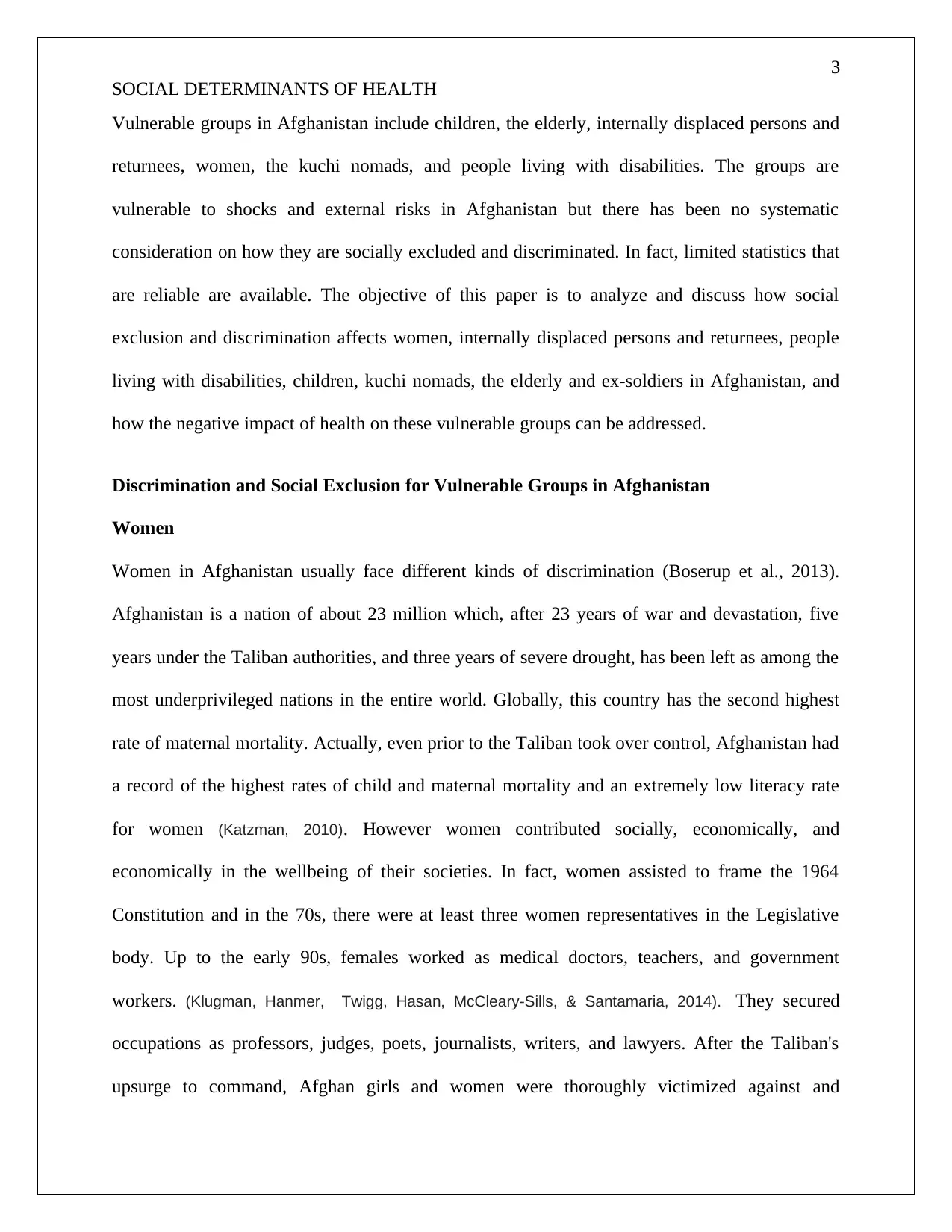
3
SOCIAL DETERMINANTS OF HEALTH
Vulnerable groups in Afghanistan include children, the elderly, internally displaced persons and
returnees, women, the kuchi nomads, and people living with disabilities. The groups are
vulnerable to shocks and external risks in Afghanistan but there has been no systematic
consideration on how they are socially excluded and discriminated. In fact, limited statistics that
are reliable are available. The objective of this paper is to analyze and discuss how social
exclusion and discrimination affects women, internally displaced persons and returnees, people
living with disabilities, children, kuchi nomads, the elderly and ex-soldiers in Afghanistan, and
how the negative impact of health on these vulnerable groups can be addressed.
Discrimination and Social Exclusion for Vulnerable Groups in Afghanistan
Women
Women in Afghanistan usually face different kinds of discrimination (Boserup et al., 2013).
Afghanistan is a nation of about 23 million which, after 23 years of war and devastation, five
years under the Taliban authorities, and three years of severe drought, has been left as among the
most underprivileged nations in the entire world. Globally, this country has the second highest
rate of maternal mortality. Actually, even prior to the Taliban took over control, Afghanistan had
a record of the highest rates of child and maternal mortality and an extremely low literacy rate
for women (Katzman, 2010). However women contributed socially, economically, and
economically in the wellbeing of their societies. In fact, women assisted to frame the 1964
Constitution and in the 70s, there were at least three women representatives in the Legislative
body. Up to the early 90s, females worked as medical doctors, teachers, and government
workers. (Klugman, Hanmer, Twigg, Hasan, McCleary-Sills, & Santamaria, 2014). They secured
occupations as professors, judges, poets, journalists, writers, and lawyers. After the Taliban's
upsurge to command, Afghan girls and women were thoroughly victimized against and
SOCIAL DETERMINANTS OF HEALTH
Vulnerable groups in Afghanistan include children, the elderly, internally displaced persons and
returnees, women, the kuchi nomads, and people living with disabilities. The groups are
vulnerable to shocks and external risks in Afghanistan but there has been no systematic
consideration on how they are socially excluded and discriminated. In fact, limited statistics that
are reliable are available. The objective of this paper is to analyze and discuss how social
exclusion and discrimination affects women, internally displaced persons and returnees, people
living with disabilities, children, kuchi nomads, the elderly and ex-soldiers in Afghanistan, and
how the negative impact of health on these vulnerable groups can be addressed.
Discrimination and Social Exclusion for Vulnerable Groups in Afghanistan
Women
Women in Afghanistan usually face different kinds of discrimination (Boserup et al., 2013).
Afghanistan is a nation of about 23 million which, after 23 years of war and devastation, five
years under the Taliban authorities, and three years of severe drought, has been left as among the
most underprivileged nations in the entire world. Globally, this country has the second highest
rate of maternal mortality. Actually, even prior to the Taliban took over control, Afghanistan had
a record of the highest rates of child and maternal mortality and an extremely low literacy rate
for women (Katzman, 2010). However women contributed socially, economically, and
economically in the wellbeing of their societies. In fact, women assisted to frame the 1964
Constitution and in the 70s, there were at least three women representatives in the Legislative
body. Up to the early 90s, females worked as medical doctors, teachers, and government
workers. (Klugman, Hanmer, Twigg, Hasan, McCleary-Sills, & Santamaria, 2014). They secured
occupations as professors, judges, poets, journalists, writers, and lawyers. After the Taliban's
upsurge to command, Afghan girls and women were thoroughly victimized against and
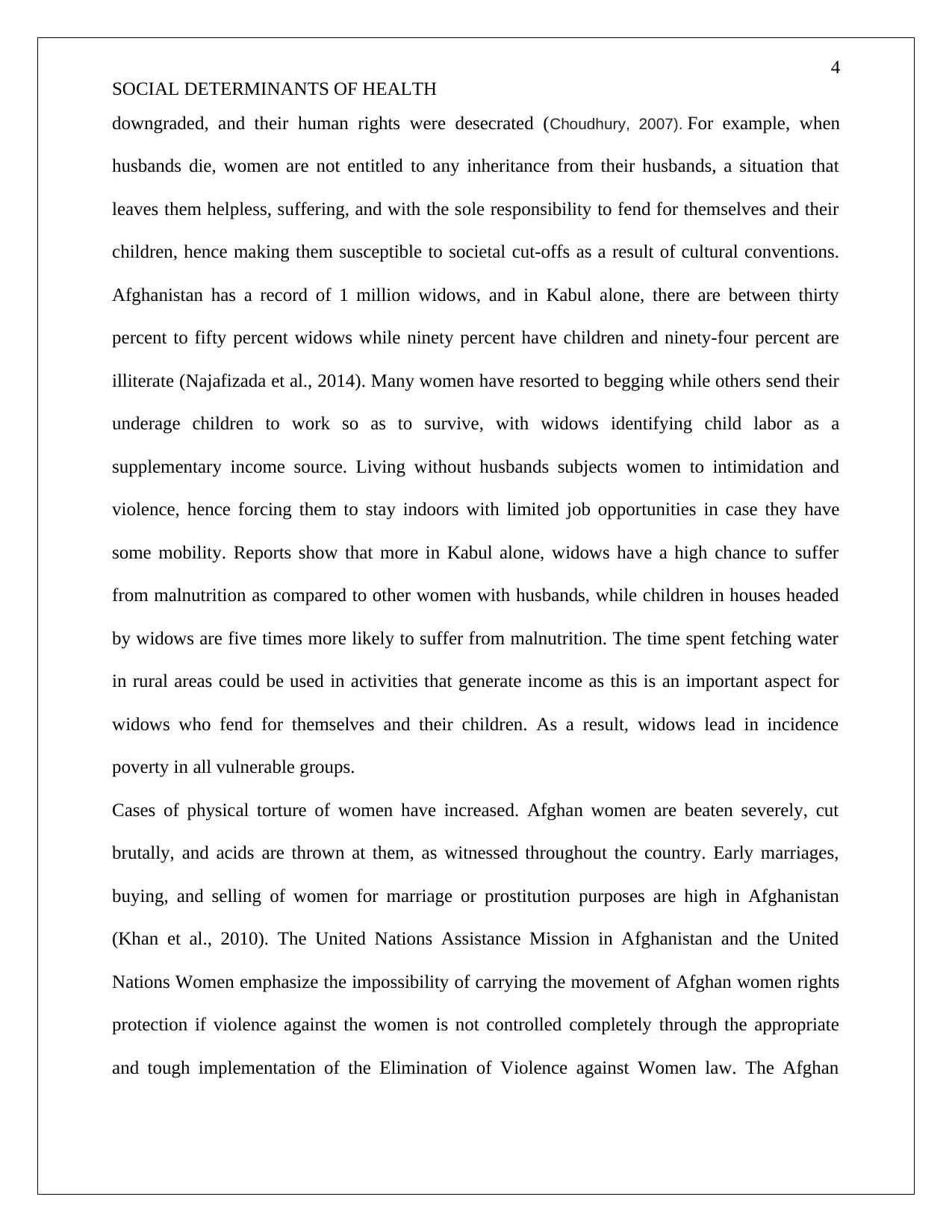
4
SOCIAL DETERMINANTS OF HEALTH
downgraded, and their human rights were desecrated (Choudhury, 2007). For example, when
husbands die, women are not entitled to any inheritance from their husbands, a situation that
leaves them helpless, suffering, and with the sole responsibility to fend for themselves and their
children, hence making them susceptible to societal cut-offs as a result of cultural conventions.
Afghanistan has a record of 1 million widows, and in Kabul alone, there are between thirty
percent to fifty percent widows while ninety percent have children and ninety-four percent are
illiterate (Najafizada et al., 2014). Many women have resorted to begging while others send their
underage children to work so as to survive, with widows identifying child labor as a
supplementary income source. Living without husbands subjects women to intimidation and
violence, hence forcing them to stay indoors with limited job opportunities in case they have
some mobility. Reports show that more in Kabul alone, widows have a high chance to suffer
from malnutrition as compared to other women with husbands, while children in houses headed
by widows are five times more likely to suffer from malnutrition. The time spent fetching water
in rural areas could be used in activities that generate income as this is an important aspect for
widows who fend for themselves and their children. As a result, widows lead in incidence
poverty in all vulnerable groups.
Cases of physical torture of women have increased. Afghan women are beaten severely, cut
brutally, and acids are thrown at them, as witnessed throughout the country. Early marriages,
buying, and selling of women for marriage or prostitution purposes are high in Afghanistan
(Khan et al., 2010). The United Nations Assistance Mission in Afghanistan and the United
Nations Women emphasize the impossibility of carrying the movement of Afghan women rights
protection if violence against the women is not controlled completely through the appropriate
and tough implementation of the Elimination of Violence against Women law. The Afghan
SOCIAL DETERMINANTS OF HEALTH
downgraded, and their human rights were desecrated (Choudhury, 2007). For example, when
husbands die, women are not entitled to any inheritance from their husbands, a situation that
leaves them helpless, suffering, and with the sole responsibility to fend for themselves and their
children, hence making them susceptible to societal cut-offs as a result of cultural conventions.
Afghanistan has a record of 1 million widows, and in Kabul alone, there are between thirty
percent to fifty percent widows while ninety percent have children and ninety-four percent are
illiterate (Najafizada et al., 2014). Many women have resorted to begging while others send their
underage children to work so as to survive, with widows identifying child labor as a
supplementary income source. Living without husbands subjects women to intimidation and
violence, hence forcing them to stay indoors with limited job opportunities in case they have
some mobility. Reports show that more in Kabul alone, widows have a high chance to suffer
from malnutrition as compared to other women with husbands, while children in houses headed
by widows are five times more likely to suffer from malnutrition. The time spent fetching water
in rural areas could be used in activities that generate income as this is an important aspect for
widows who fend for themselves and their children. As a result, widows lead in incidence
poverty in all vulnerable groups.
Cases of physical torture of women have increased. Afghan women are beaten severely, cut
brutally, and acids are thrown at them, as witnessed throughout the country. Early marriages,
buying, and selling of women for marriage or prostitution purposes are high in Afghanistan
(Khan et al., 2010). The United Nations Assistance Mission in Afghanistan and the United
Nations Women emphasize the impossibility of carrying the movement of Afghan women rights
protection if violence against the women is not controlled completely through the appropriate
and tough implementation of the Elimination of Violence against Women law. The Afghan
Secure Best Marks with AI Grader
Need help grading? Try our AI Grader for instant feedback on your assignments.
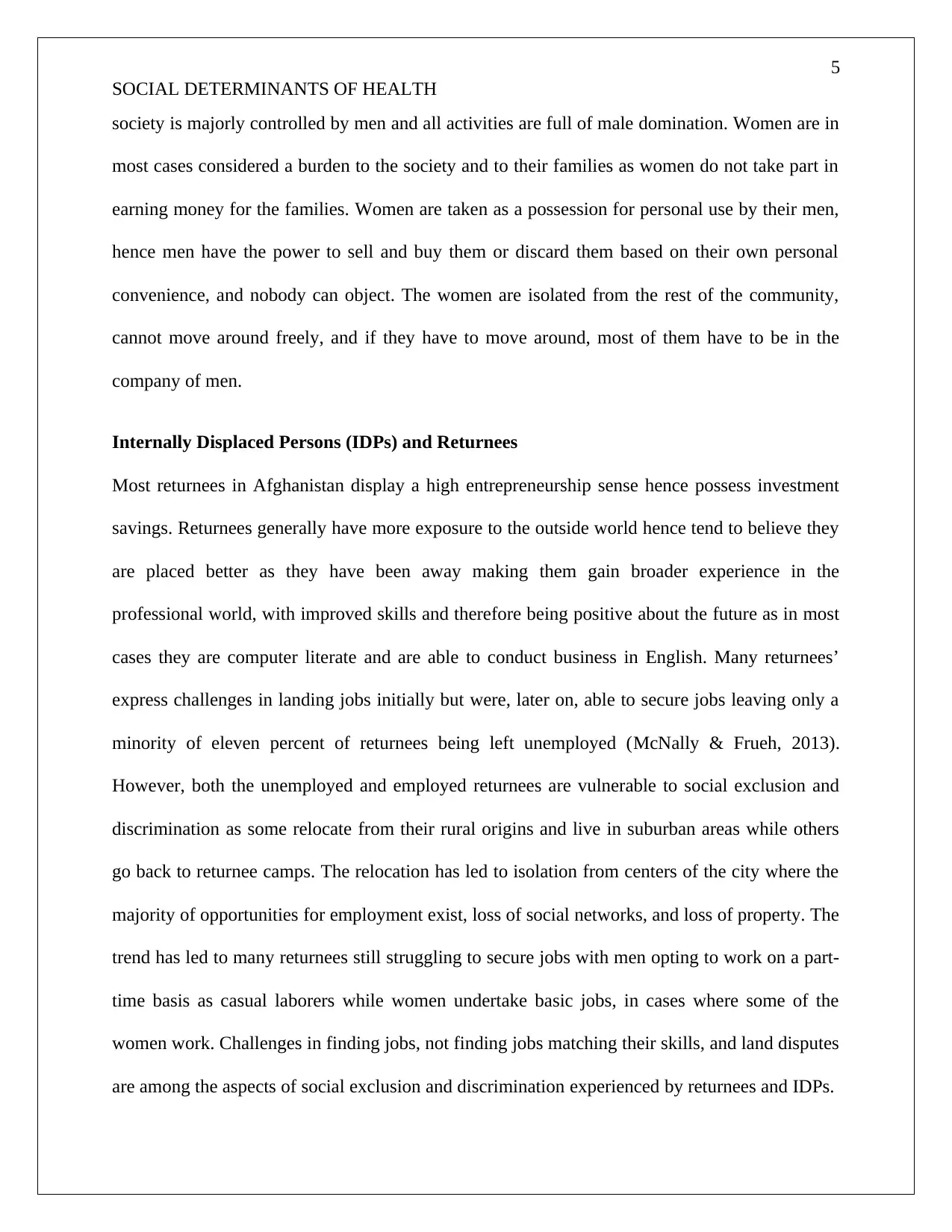
5
SOCIAL DETERMINANTS OF HEALTH
society is majorly controlled by men and all activities are full of male domination. Women are in
most cases considered a burden to the society and to their families as women do not take part in
earning money for the families. Women are taken as a possession for personal use by their men,
hence men have the power to sell and buy them or discard them based on their own personal
convenience, and nobody can object. The women are isolated from the rest of the community,
cannot move around freely, and if they have to move around, most of them have to be in the
company of men.
Internally Displaced Persons (IDPs) and Returnees
Most returnees in Afghanistan display a high entrepreneurship sense hence possess investment
savings. Returnees generally have more exposure to the outside world hence tend to believe they
are placed better as they have been away making them gain broader experience in the
professional world, with improved skills and therefore being positive about the future as in most
cases they are computer literate and are able to conduct business in English. Many returnees’
express challenges in landing jobs initially but were, later on, able to secure jobs leaving only a
minority of eleven percent of returnees being left unemployed (McNally & Frueh, 2013).
However, both the unemployed and employed returnees are vulnerable to social exclusion and
discrimination as some relocate from their rural origins and live in suburban areas while others
go back to returnee camps. The relocation has led to isolation from centers of the city where the
majority of opportunities for employment exist, loss of social networks, and loss of property. The
trend has led to many returnees still struggling to secure jobs with men opting to work on a part-
time basis as casual laborers while women undertake basic jobs, in cases where some of the
women work. Challenges in finding jobs, not finding jobs matching their skills, and land disputes
are among the aspects of social exclusion and discrimination experienced by returnees and IDPs.
SOCIAL DETERMINANTS OF HEALTH
society is majorly controlled by men and all activities are full of male domination. Women are in
most cases considered a burden to the society and to their families as women do not take part in
earning money for the families. Women are taken as a possession for personal use by their men,
hence men have the power to sell and buy them or discard them based on their own personal
convenience, and nobody can object. The women are isolated from the rest of the community,
cannot move around freely, and if they have to move around, most of them have to be in the
company of men.
Internally Displaced Persons (IDPs) and Returnees
Most returnees in Afghanistan display a high entrepreneurship sense hence possess investment
savings. Returnees generally have more exposure to the outside world hence tend to believe they
are placed better as they have been away making them gain broader experience in the
professional world, with improved skills and therefore being positive about the future as in most
cases they are computer literate and are able to conduct business in English. Many returnees’
express challenges in landing jobs initially but were, later on, able to secure jobs leaving only a
minority of eleven percent of returnees being left unemployed (McNally & Frueh, 2013).
However, both the unemployed and employed returnees are vulnerable to social exclusion and
discrimination as some relocate from their rural origins and live in suburban areas while others
go back to returnee camps. The relocation has led to isolation from centers of the city where the
majority of opportunities for employment exist, loss of social networks, and loss of property. The
trend has led to many returnees still struggling to secure jobs with men opting to work on a part-
time basis as casual laborers while women undertake basic jobs, in cases where some of the
women work. Challenges in finding jobs, not finding jobs matching their skills, and land disputes
are among the aspects of social exclusion and discrimination experienced by returnees and IDPs.
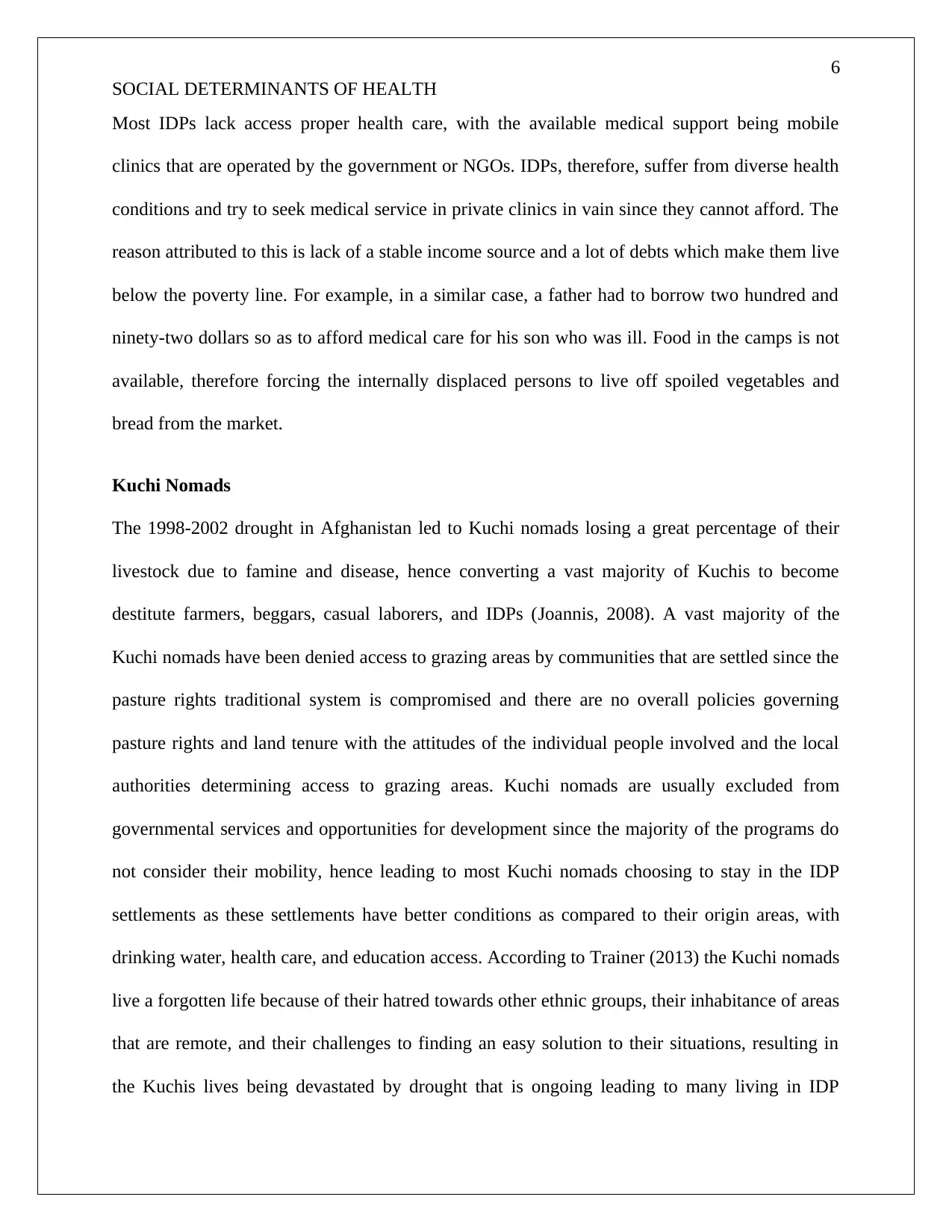
6
SOCIAL DETERMINANTS OF HEALTH
Most IDPs lack access proper health care, with the available medical support being mobile
clinics that are operated by the government or NGOs. IDPs, therefore, suffer from diverse health
conditions and try to seek medical service in private clinics in vain since they cannot afford. The
reason attributed to this is lack of a stable income source and a lot of debts which make them live
below the poverty line. For example, in a similar case, a father had to borrow two hundred and
ninety-two dollars so as to afford medical care for his son who was ill. Food in the camps is not
available, therefore forcing the internally displaced persons to live off spoiled vegetables and
bread from the market.
Kuchi Nomads
The 1998-2002 drought in Afghanistan led to Kuchi nomads losing a great percentage of their
livestock due to famine and disease, hence converting a vast majority of Kuchis to become
destitute farmers, beggars, casual laborers, and IDPs (Joannis, 2008). A vast majority of the
Kuchi nomads have been denied access to grazing areas by communities that are settled since the
pasture rights traditional system is compromised and there are no overall policies governing
pasture rights and land tenure with the attitudes of the individual people involved and the local
authorities determining access to grazing areas. Kuchi nomads are usually excluded from
governmental services and opportunities for development since the majority of the programs do
not consider their mobility, hence leading to most Kuchi nomads choosing to stay in the IDP
settlements as these settlements have better conditions as compared to their origin areas, with
drinking water, health care, and education access. According to Trainer (2013) the Kuchi nomads
live a forgotten life because of their hatred towards other ethnic groups, their inhabitance of areas
that are remote, and their challenges to finding an easy solution to their situations, resulting in
the Kuchis lives being devastated by drought that is ongoing leading to many living in IDP
SOCIAL DETERMINANTS OF HEALTH
Most IDPs lack access proper health care, with the available medical support being mobile
clinics that are operated by the government or NGOs. IDPs, therefore, suffer from diverse health
conditions and try to seek medical service in private clinics in vain since they cannot afford. The
reason attributed to this is lack of a stable income source and a lot of debts which make them live
below the poverty line. For example, in a similar case, a father had to borrow two hundred and
ninety-two dollars so as to afford medical care for his son who was ill. Food in the camps is not
available, therefore forcing the internally displaced persons to live off spoiled vegetables and
bread from the market.
Kuchi Nomads
The 1998-2002 drought in Afghanistan led to Kuchi nomads losing a great percentage of their
livestock due to famine and disease, hence converting a vast majority of Kuchis to become
destitute farmers, beggars, casual laborers, and IDPs (Joannis, 2008). A vast majority of the
Kuchi nomads have been denied access to grazing areas by communities that are settled since the
pasture rights traditional system is compromised and there are no overall policies governing
pasture rights and land tenure with the attitudes of the individual people involved and the local
authorities determining access to grazing areas. Kuchi nomads are usually excluded from
governmental services and opportunities for development since the majority of the programs do
not consider their mobility, hence leading to most Kuchi nomads choosing to stay in the IDP
settlements as these settlements have better conditions as compared to their origin areas, with
drinking water, health care, and education access. According to Trainer (2013) the Kuchi nomads
live a forgotten life because of their hatred towards other ethnic groups, their inhabitance of areas
that are remote, and their challenges to finding an easy solution to their situations, resulting in
the Kuchis lives being devastated by drought that is ongoing leading to many living in IDP
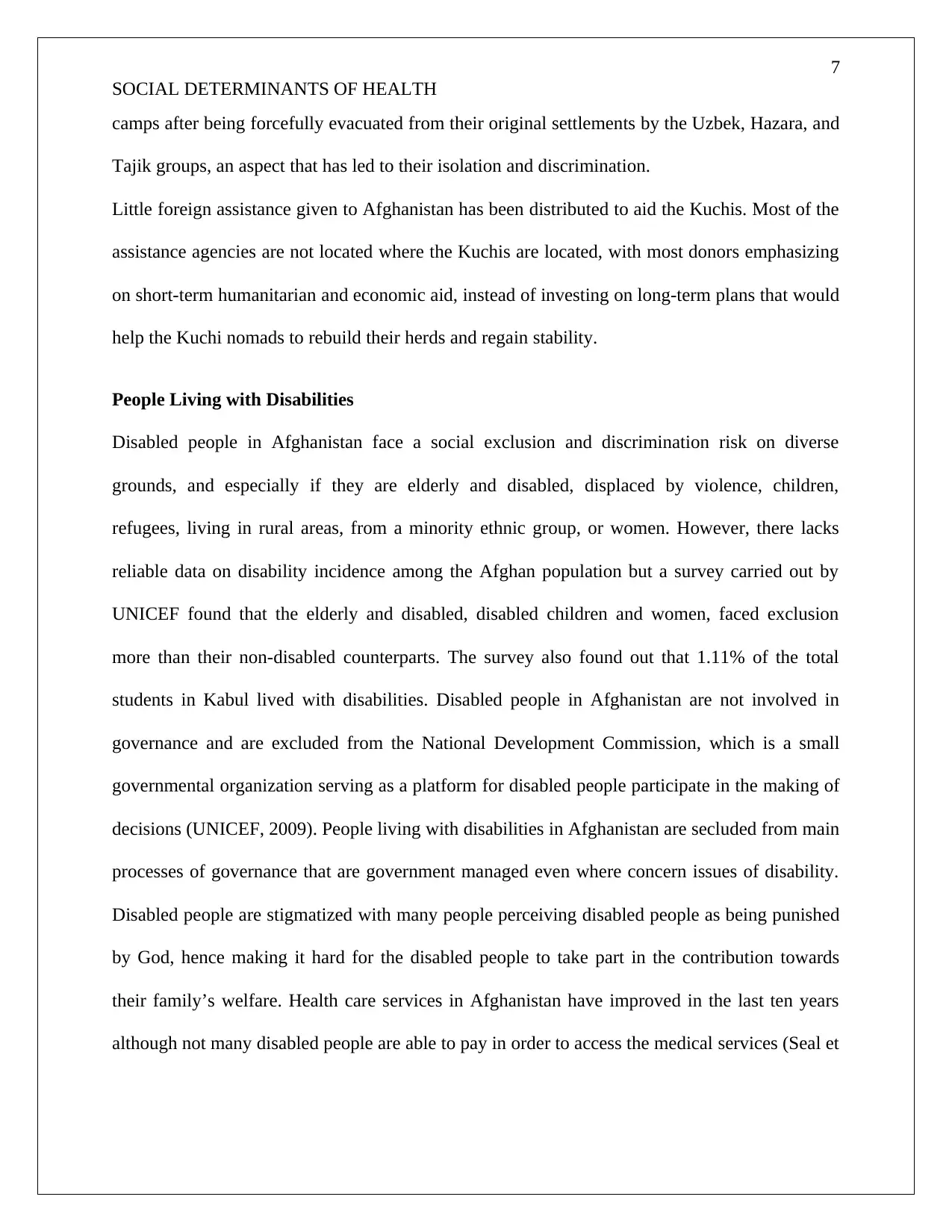
7
SOCIAL DETERMINANTS OF HEALTH
camps after being forcefully evacuated from their original settlements by the Uzbek, Hazara, and
Tajik groups, an aspect that has led to their isolation and discrimination.
Little foreign assistance given to Afghanistan has been distributed to aid the Kuchis. Most of the
assistance agencies are not located where the Kuchis are located, with most donors emphasizing
on short-term humanitarian and economic aid, instead of investing on long-term plans that would
help the Kuchi nomads to rebuild their herds and regain stability.
People Living with Disabilities
Disabled people in Afghanistan face a social exclusion and discrimination risk on diverse
grounds, and especially if they are elderly and disabled, displaced by violence, children,
refugees, living in rural areas, from a minority ethnic group, or women. However, there lacks
reliable data on disability incidence among the Afghan population but a survey carried out by
UNICEF found that the elderly and disabled, disabled children and women, faced exclusion
more than their non-disabled counterparts. The survey also found out that 1.11% of the total
students in Kabul lived with disabilities. Disabled people in Afghanistan are not involved in
governance and are excluded from the National Development Commission, which is a small
governmental organization serving as a platform for disabled people participate in the making of
decisions (UNICEF, 2009). People living with disabilities in Afghanistan are secluded from main
processes of governance that are government managed even where concern issues of disability.
Disabled people are stigmatized with many people perceiving disabled people as being punished
by God, hence making it hard for the disabled people to take part in the contribution towards
their family’s welfare. Health care services in Afghanistan have improved in the last ten years
although not many disabled people are able to pay in order to access the medical services (Seal et
SOCIAL DETERMINANTS OF HEALTH
camps after being forcefully evacuated from their original settlements by the Uzbek, Hazara, and
Tajik groups, an aspect that has led to their isolation and discrimination.
Little foreign assistance given to Afghanistan has been distributed to aid the Kuchis. Most of the
assistance agencies are not located where the Kuchis are located, with most donors emphasizing
on short-term humanitarian and economic aid, instead of investing on long-term plans that would
help the Kuchi nomads to rebuild their herds and regain stability.
People Living with Disabilities
Disabled people in Afghanistan face a social exclusion and discrimination risk on diverse
grounds, and especially if they are elderly and disabled, displaced by violence, children,
refugees, living in rural areas, from a minority ethnic group, or women. However, there lacks
reliable data on disability incidence among the Afghan population but a survey carried out by
UNICEF found that the elderly and disabled, disabled children and women, faced exclusion
more than their non-disabled counterparts. The survey also found out that 1.11% of the total
students in Kabul lived with disabilities. Disabled people in Afghanistan are not involved in
governance and are excluded from the National Development Commission, which is a small
governmental organization serving as a platform for disabled people participate in the making of
decisions (UNICEF, 2009). People living with disabilities in Afghanistan are secluded from main
processes of governance that are government managed even where concern issues of disability.
Disabled people are stigmatized with many people perceiving disabled people as being punished
by God, hence making it hard for the disabled people to take part in the contribution towards
their family’s welfare. Health care services in Afghanistan have improved in the last ten years
although not many disabled people are able to pay in order to access the medical services (Seal et
Paraphrase This Document
Need a fresh take? Get an instant paraphrase of this document with our AI Paraphraser
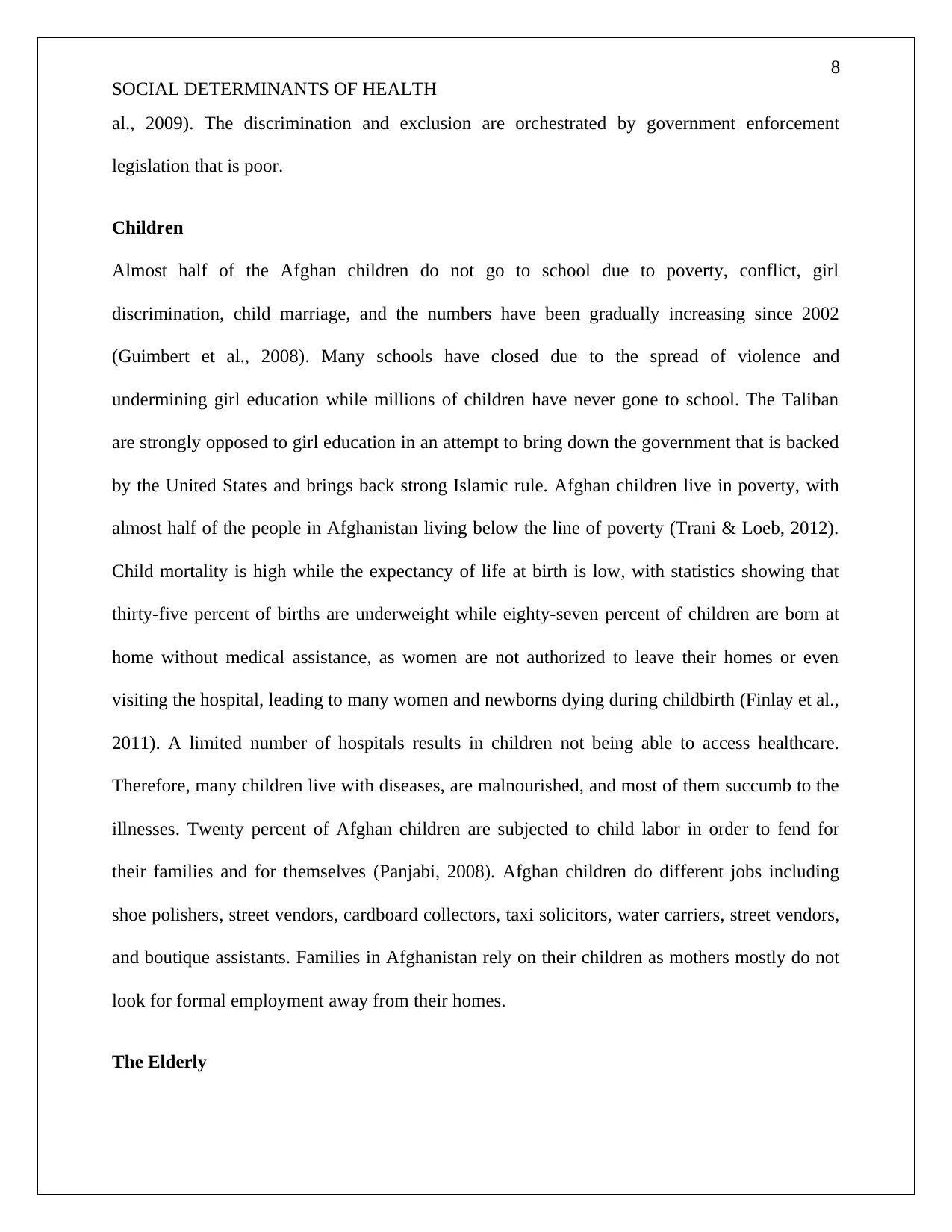
8
SOCIAL DETERMINANTS OF HEALTH
al., 2009). The discrimination and exclusion are orchestrated by government enforcement
legislation that is poor.
Children
Almost half of the Afghan children do not go to school due to poverty, conflict, girl
discrimination, child marriage, and the numbers have been gradually increasing since 2002
(Guimbert et al., 2008). Many schools have closed due to the spread of violence and
undermining girl education while millions of children have never gone to school. The Taliban
are strongly opposed to girl education in an attempt to bring down the government that is backed
by the United States and brings back strong Islamic rule. Afghan children live in poverty, with
almost half of the people in Afghanistan living below the line of poverty (Trani & Loeb, 2012).
Child mortality is high while the expectancy of life at birth is low, with statistics showing that
thirty-five percent of births are underweight while eighty-seven percent of children are born at
home without medical assistance, as women are not authorized to leave their homes or even
visiting the hospital, leading to many women and newborns dying during childbirth (Finlay et al.,
2011). A limited number of hospitals results in children not being able to access healthcare.
Therefore, many children live with diseases, are malnourished, and most of them succumb to the
illnesses. Twenty percent of Afghan children are subjected to child labor in order to fend for
their families and for themselves (Panjabi, 2008). Afghan children do different jobs including
shoe polishers, street vendors, cardboard collectors, taxi solicitors, water carriers, street vendors,
and boutique assistants. Families in Afghanistan rely on their children as mothers mostly do not
look for formal employment away from their homes.
The Elderly
SOCIAL DETERMINANTS OF HEALTH
al., 2009). The discrimination and exclusion are orchestrated by government enforcement
legislation that is poor.
Children
Almost half of the Afghan children do not go to school due to poverty, conflict, girl
discrimination, child marriage, and the numbers have been gradually increasing since 2002
(Guimbert et al., 2008). Many schools have closed due to the spread of violence and
undermining girl education while millions of children have never gone to school. The Taliban
are strongly opposed to girl education in an attempt to bring down the government that is backed
by the United States and brings back strong Islamic rule. Afghan children live in poverty, with
almost half of the people in Afghanistan living below the line of poverty (Trani & Loeb, 2012).
Child mortality is high while the expectancy of life at birth is low, with statistics showing that
thirty-five percent of births are underweight while eighty-seven percent of children are born at
home without medical assistance, as women are not authorized to leave their homes or even
visiting the hospital, leading to many women and newborns dying during childbirth (Finlay et al.,
2011). A limited number of hospitals results in children not being able to access healthcare.
Therefore, many children live with diseases, are malnourished, and most of them succumb to the
illnesses. Twenty percent of Afghan children are subjected to child labor in order to fend for
their families and for themselves (Panjabi, 2008). Afghan children do different jobs including
shoe polishers, street vendors, cardboard collectors, taxi solicitors, water carriers, street vendors,
and boutique assistants. Families in Afghanistan rely on their children as mothers mostly do not
look for formal employment away from their homes.
The Elderly
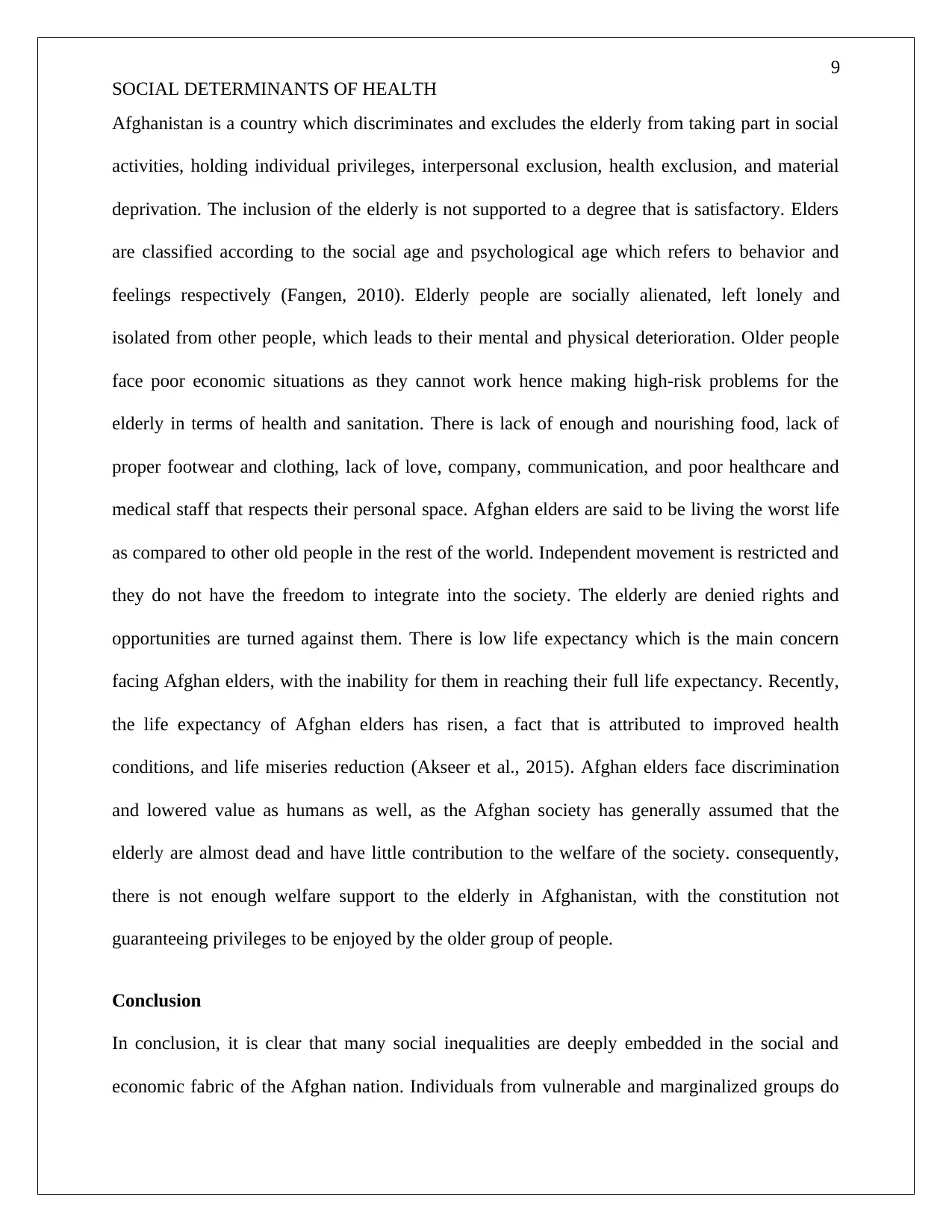
9
SOCIAL DETERMINANTS OF HEALTH
Afghanistan is a country which discriminates and excludes the elderly from taking part in social
activities, holding individual privileges, interpersonal exclusion, health exclusion, and material
deprivation. The inclusion of the elderly is not supported to a degree that is satisfactory. Elders
are classified according to the social age and psychological age which refers to behavior and
feelings respectively (Fangen, 2010). Elderly people are socially alienated, left lonely and
isolated from other people, which leads to their mental and physical deterioration. Older people
face poor economic situations as they cannot work hence making high-risk problems for the
elderly in terms of health and sanitation. There is lack of enough and nourishing food, lack of
proper footwear and clothing, lack of love, company, communication, and poor healthcare and
medical staff that respects their personal space. Afghan elders are said to be living the worst life
as compared to other old people in the rest of the world. Independent movement is restricted and
they do not have the freedom to integrate into the society. The elderly are denied rights and
opportunities are turned against them. There is low life expectancy which is the main concern
facing Afghan elders, with the inability for them in reaching their full life expectancy. Recently,
the life expectancy of Afghan elders has risen, a fact that is attributed to improved health
conditions, and life miseries reduction (Akseer et al., 2015). Afghan elders face discrimination
and lowered value as humans as well, as the Afghan society has generally assumed that the
elderly are almost dead and have little contribution to the welfare of the society. consequently,
there is not enough welfare support to the elderly in Afghanistan, with the constitution not
guaranteeing privileges to be enjoyed by the older group of people.
Conclusion
In conclusion, it is clear that many social inequalities are deeply embedded in the social and
economic fabric of the Afghan nation. Individuals from vulnerable and marginalized groups do
SOCIAL DETERMINANTS OF HEALTH
Afghanistan is a country which discriminates and excludes the elderly from taking part in social
activities, holding individual privileges, interpersonal exclusion, health exclusion, and material
deprivation. The inclusion of the elderly is not supported to a degree that is satisfactory. Elders
are classified according to the social age and psychological age which refers to behavior and
feelings respectively (Fangen, 2010). Elderly people are socially alienated, left lonely and
isolated from other people, which leads to their mental and physical deterioration. Older people
face poor economic situations as they cannot work hence making high-risk problems for the
elderly in terms of health and sanitation. There is lack of enough and nourishing food, lack of
proper footwear and clothing, lack of love, company, communication, and poor healthcare and
medical staff that respects their personal space. Afghan elders are said to be living the worst life
as compared to other old people in the rest of the world. Independent movement is restricted and
they do not have the freedom to integrate into the society. The elderly are denied rights and
opportunities are turned against them. There is low life expectancy which is the main concern
facing Afghan elders, with the inability for them in reaching their full life expectancy. Recently,
the life expectancy of Afghan elders has risen, a fact that is attributed to improved health
conditions, and life miseries reduction (Akseer et al., 2015). Afghan elders face discrimination
and lowered value as humans as well, as the Afghan society has generally assumed that the
elderly are almost dead and have little contribution to the welfare of the society. consequently,
there is not enough welfare support to the elderly in Afghanistan, with the constitution not
guaranteeing privileges to be enjoyed by the older group of people.
Conclusion
In conclusion, it is clear that many social inequalities are deeply embedded in the social and
economic fabric of the Afghan nation. Individuals from vulnerable and marginalized groups do
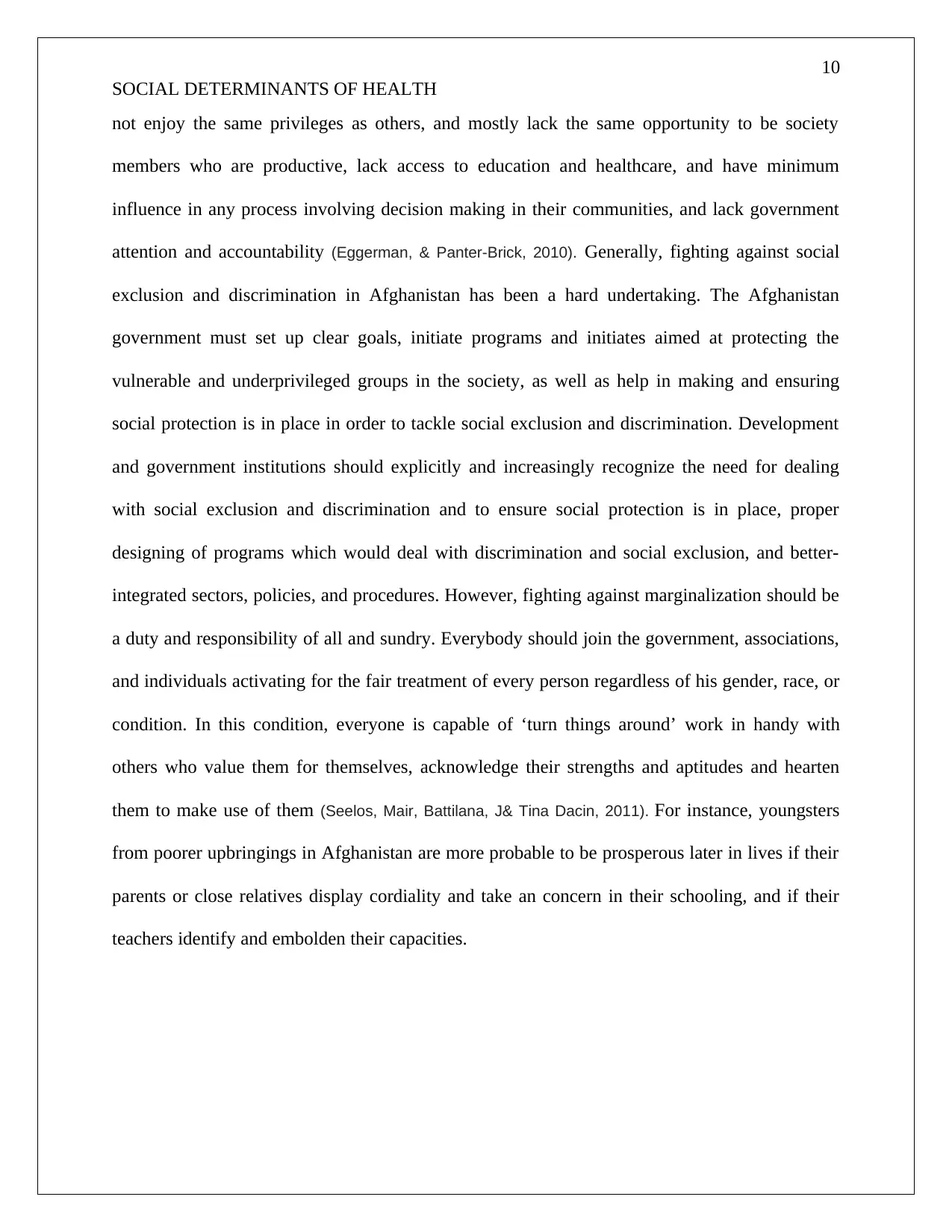
10
SOCIAL DETERMINANTS OF HEALTH
not enjoy the same privileges as others, and mostly lack the same opportunity to be society
members who are productive, lack access to education and healthcare, and have minimum
influence in any process involving decision making in their communities, and lack government
attention and accountability (Eggerman, & Panter-Brick, 2010). Generally, fighting against social
exclusion and discrimination in Afghanistan has been a hard undertaking. The Afghanistan
government must set up clear goals, initiate programs and initiates aimed at protecting the
vulnerable and underprivileged groups in the society, as well as help in making and ensuring
social protection is in place in order to tackle social exclusion and discrimination. Development
and government institutions should explicitly and increasingly recognize the need for dealing
with social exclusion and discrimination and to ensure social protection is in place, proper
designing of programs which would deal with discrimination and social exclusion, and better-
integrated sectors, policies, and procedures. However, fighting against marginalization should be
a duty and responsibility of all and sundry. Everybody should join the government, associations,
and individuals activating for the fair treatment of every person regardless of his gender, race, or
condition. In this condition, everyone is capable of ‘turn things around’ work in handy with
others who value them for themselves, acknowledge their strengths and aptitudes and hearten
them to make use of them (Seelos, Mair, Battilana, J& Tina Dacin, 2011). For instance, youngsters
from poorer upbringings in Afghanistan are more probable to be prosperous later in lives if their
parents or close relatives display cordiality and take an concern in their schooling, and if their
teachers identify and embolden their capacities.
SOCIAL DETERMINANTS OF HEALTH
not enjoy the same privileges as others, and mostly lack the same opportunity to be society
members who are productive, lack access to education and healthcare, and have minimum
influence in any process involving decision making in their communities, and lack government
attention and accountability (Eggerman, & Panter-Brick, 2010). Generally, fighting against social
exclusion and discrimination in Afghanistan has been a hard undertaking. The Afghanistan
government must set up clear goals, initiate programs and initiates aimed at protecting the
vulnerable and underprivileged groups in the society, as well as help in making and ensuring
social protection is in place in order to tackle social exclusion and discrimination. Development
and government institutions should explicitly and increasingly recognize the need for dealing
with social exclusion and discrimination and to ensure social protection is in place, proper
designing of programs which would deal with discrimination and social exclusion, and better-
integrated sectors, policies, and procedures. However, fighting against marginalization should be
a duty and responsibility of all and sundry. Everybody should join the government, associations,
and individuals activating for the fair treatment of every person regardless of his gender, race, or
condition. In this condition, everyone is capable of ‘turn things around’ work in handy with
others who value them for themselves, acknowledge their strengths and aptitudes and hearten
them to make use of them (Seelos, Mair, Battilana, J& Tina Dacin, 2011). For instance, youngsters
from poorer upbringings in Afghanistan are more probable to be prosperous later in lives if their
parents or close relatives display cordiality and take an concern in their schooling, and if their
teachers identify and embolden their capacities.
Secure Best Marks with AI Grader
Need help grading? Try our AI Grader for instant feedback on your assignments.
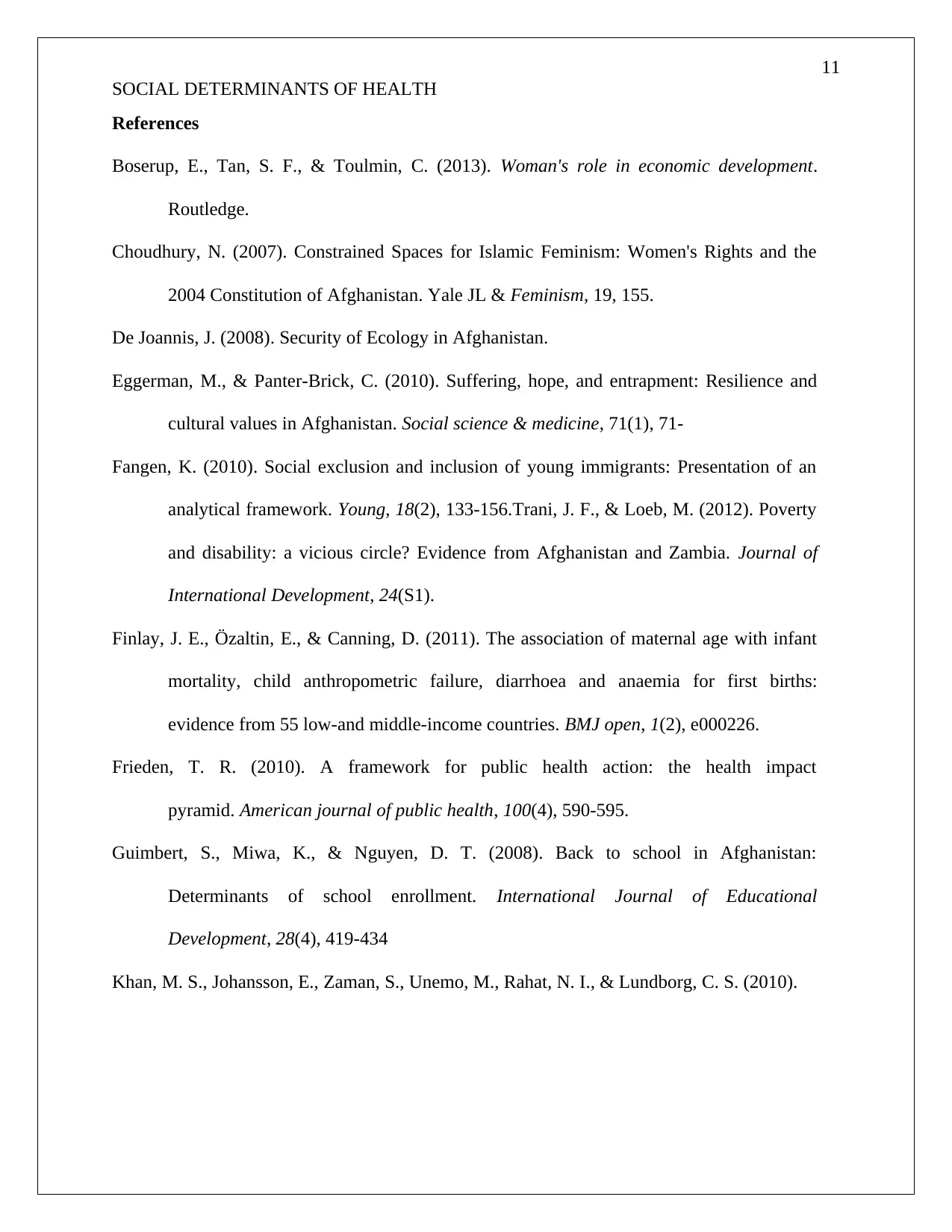
11
SOCIAL DETERMINANTS OF HEALTH
References
Boserup, E., Tan, S. F., & Toulmin, C. (2013). Woman's role in economic development.
Routledge.
Choudhury, N. (2007). Constrained Spaces for Islamic Feminism: Women's Rights and the
2004 Constitution of Afghanistan. Yale JL & Feminism, 19, 155.
De Joannis, J. (2008). Security of Ecology in Afghanistan.
Eggerman, M., & Panter-Brick, C. (2010). Suffering, hope, and entrapment: Resilience and
cultural values in Afghanistan. Social science & medicine, 71(1), 71-
Fangen, K. (2010). Social exclusion and inclusion of young immigrants: Presentation of an
analytical framework. Young, 18(2), 133-156.Trani, J. F., & Loeb, M. (2012). Poverty
and disability: a vicious circle? Evidence from Afghanistan and Zambia. Journal of
International Development, 24(S1).
Finlay, J. E., Özaltin, E., & Canning, D. (2011). The association of maternal age with infant
mortality, child anthropometric failure, diarrhoea and anaemia for first births:
evidence from 55 low-and middle-income countries. BMJ open, 1(2), e000226.
Frieden, T. R. (2010). A framework for public health action: the health impact
pyramid. American journal of public health, 100(4), 590-595.
Guimbert, S., Miwa, K., & Nguyen, D. T. (2008). Back to school in Afghanistan:
Determinants of school enrollment. International Journal of Educational
Development, 28(4), 419-434
Khan, M. S., Johansson, E., Zaman, S., Unemo, M., Rahat, N. I., & Lundborg, C. S. (2010).
SOCIAL DETERMINANTS OF HEALTH
References
Boserup, E., Tan, S. F., & Toulmin, C. (2013). Woman's role in economic development.
Routledge.
Choudhury, N. (2007). Constrained Spaces for Islamic Feminism: Women's Rights and the
2004 Constitution of Afghanistan. Yale JL & Feminism, 19, 155.
De Joannis, J. (2008). Security of Ecology in Afghanistan.
Eggerman, M., & Panter-Brick, C. (2010). Suffering, hope, and entrapment: Resilience and
cultural values in Afghanistan. Social science & medicine, 71(1), 71-
Fangen, K. (2010). Social exclusion and inclusion of young immigrants: Presentation of an
analytical framework. Young, 18(2), 133-156.Trani, J. F., & Loeb, M. (2012). Poverty
and disability: a vicious circle? Evidence from Afghanistan and Zambia. Journal of
International Development, 24(S1).
Finlay, J. E., Özaltin, E., & Canning, D. (2011). The association of maternal age with infant
mortality, child anthropometric failure, diarrhoea and anaemia for first births:
evidence from 55 low-and middle-income countries. BMJ open, 1(2), e000226.
Frieden, T. R. (2010). A framework for public health action: the health impact
pyramid. American journal of public health, 100(4), 590-595.
Guimbert, S., Miwa, K., & Nguyen, D. T. (2008). Back to school in Afghanistan:
Determinants of school enrollment. International Journal of Educational
Development, 28(4), 419-434
Khan, M. S., Johansson, E., Zaman, S., Unemo, M., Rahat, N. I., & Lundborg, C. S. (2010).
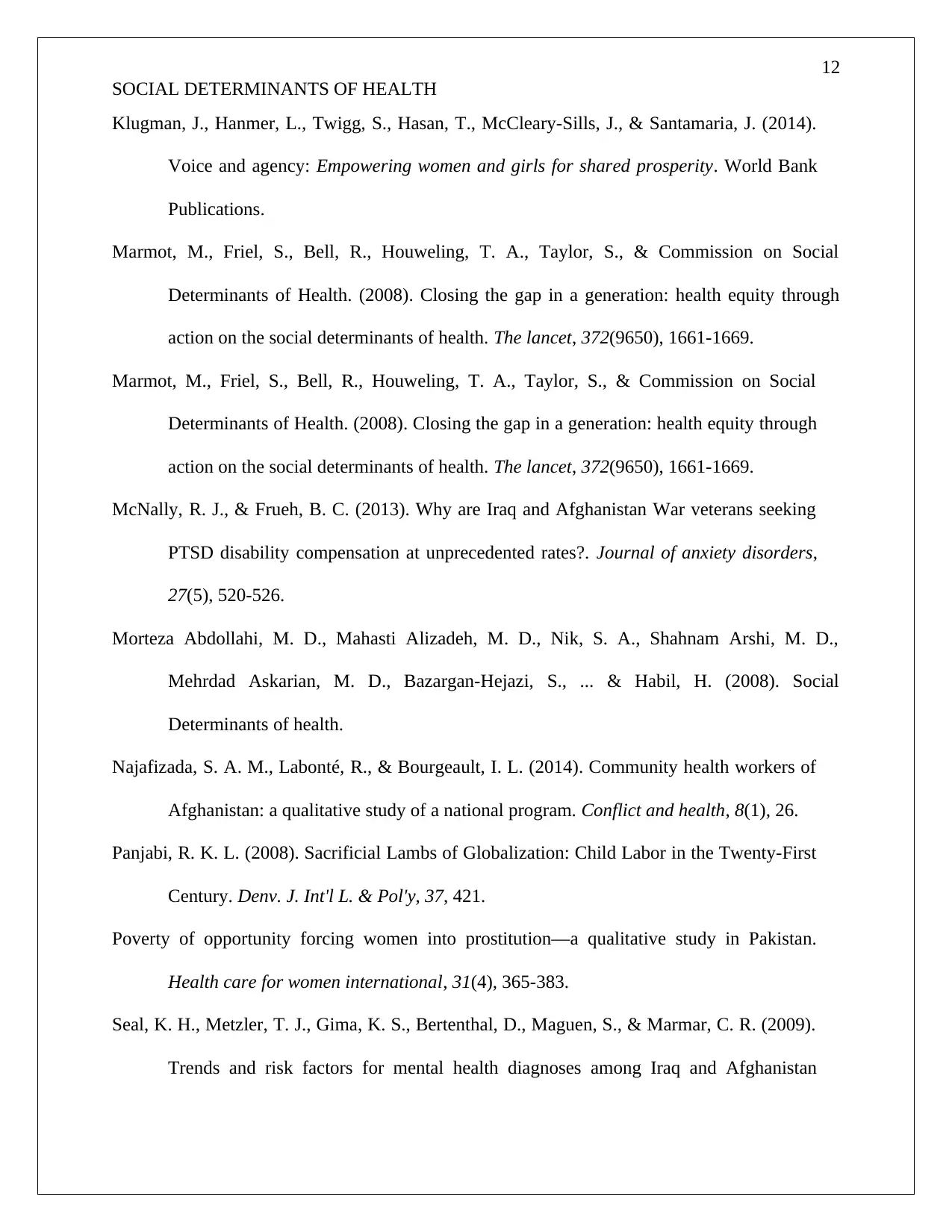
12
SOCIAL DETERMINANTS OF HEALTH
Klugman, J., Hanmer, L., Twigg, S., Hasan, T., McCleary-Sills, J., & Santamaria, J. (2014).
Voice and agency: Empowering women and girls for shared prosperity. World Bank
Publications.
Marmot, M., Friel, S., Bell, R., Houweling, T. A., Taylor, S., & Commission on Social
Determinants of Health. (2008). Closing the gap in a generation: health equity through
action on the social determinants of health. The lancet, 372(9650), 1661-1669.
Marmot, M., Friel, S., Bell, R., Houweling, T. A., Taylor, S., & Commission on Social
Determinants of Health. (2008). Closing the gap in a generation: health equity through
action on the social determinants of health. The lancet, 372(9650), 1661-1669.
McNally, R. J., & Frueh, B. C. (2013). Why are Iraq and Afghanistan War veterans seeking
PTSD disability compensation at unprecedented rates?. Journal of anxiety disorders,
27(5), 520-526.
Morteza Abdollahi, M. D., Mahasti Alizadeh, M. D., Nik, S. A., Shahnam Arshi, M. D.,
Mehrdad Askarian, M. D., Bazargan-Hejazi, S., ... & Habil, H. (2008). Social
Determinants of health.
Najafizada, S. A. M., Labonté, R., & Bourgeault, I. L. (2014). Community health workers of
Afghanistan: a qualitative study of a national program. Conflict and health, 8(1), 26.
Panjabi, R. K. L. (2008). Sacrificial Lambs of Globalization: Child Labor in the Twenty-First
Century. Denv. J. Int'l L. & Pol'y, 37, 421.
Poverty of opportunity forcing women into prostitution—a qualitative study in Pakistan.
Health care for women international, 31(4), 365-383.
Seal, K. H., Metzler, T. J., Gima, K. S., Bertenthal, D., Maguen, S., & Marmar, C. R. (2009).
Trends and risk factors for mental health diagnoses among Iraq and Afghanistan
SOCIAL DETERMINANTS OF HEALTH
Klugman, J., Hanmer, L., Twigg, S., Hasan, T., McCleary-Sills, J., & Santamaria, J. (2014).
Voice and agency: Empowering women and girls for shared prosperity. World Bank
Publications.
Marmot, M., Friel, S., Bell, R., Houweling, T. A., Taylor, S., & Commission on Social
Determinants of Health. (2008). Closing the gap in a generation: health equity through
action on the social determinants of health. The lancet, 372(9650), 1661-1669.
Marmot, M., Friel, S., Bell, R., Houweling, T. A., Taylor, S., & Commission on Social
Determinants of Health. (2008). Closing the gap in a generation: health equity through
action on the social determinants of health. The lancet, 372(9650), 1661-1669.
McNally, R. J., & Frueh, B. C. (2013). Why are Iraq and Afghanistan War veterans seeking
PTSD disability compensation at unprecedented rates?. Journal of anxiety disorders,
27(5), 520-526.
Morteza Abdollahi, M. D., Mahasti Alizadeh, M. D., Nik, S. A., Shahnam Arshi, M. D.,
Mehrdad Askarian, M. D., Bazargan-Hejazi, S., ... & Habil, H. (2008). Social
Determinants of health.
Najafizada, S. A. M., Labonté, R., & Bourgeault, I. L. (2014). Community health workers of
Afghanistan: a qualitative study of a national program. Conflict and health, 8(1), 26.
Panjabi, R. K. L. (2008). Sacrificial Lambs of Globalization: Child Labor in the Twenty-First
Century. Denv. J. Int'l L. & Pol'y, 37, 421.
Poverty of opportunity forcing women into prostitution—a qualitative study in Pakistan.
Health care for women international, 31(4), 365-383.
Seal, K. H., Metzler, T. J., Gima, K. S., Bertenthal, D., Maguen, S., & Marmar, C. R. (2009).
Trends and risk factors for mental health diagnoses among Iraq and Afghanistan
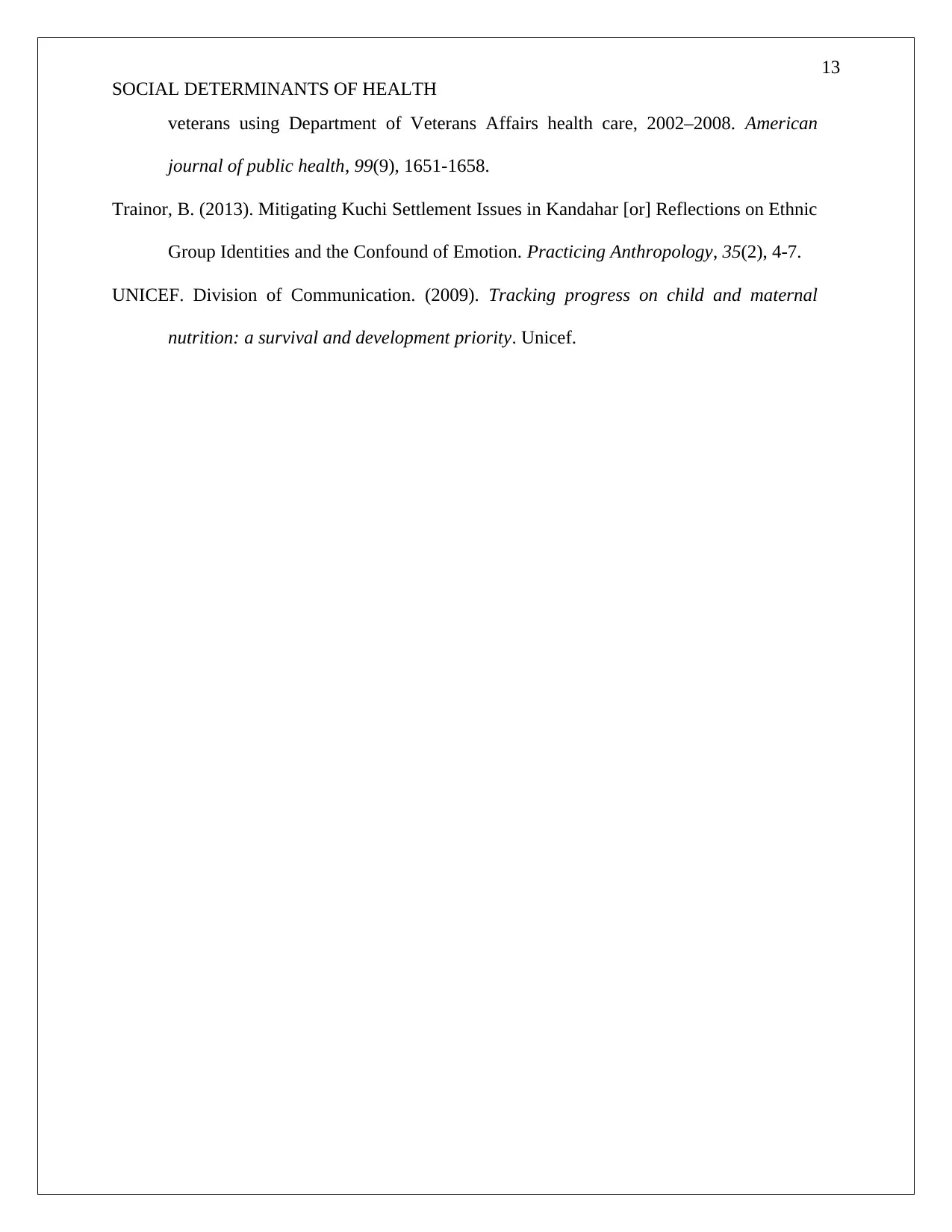
13
SOCIAL DETERMINANTS OF HEALTH
veterans using Department of Veterans Affairs health care, 2002–2008. American
journal of public health, 99(9), 1651-1658.
Trainor, B. (2013). Mitigating Kuchi Settlement Issues in Kandahar [or] Reflections on Ethnic
Group Identities and the Confound of Emotion. Practicing Anthropology, 35(2), 4-7.
UNICEF. Division of Communication. (2009). Tracking progress on child and maternal
nutrition: a survival and development priority. Unicef.
SOCIAL DETERMINANTS OF HEALTH
veterans using Department of Veterans Affairs health care, 2002–2008. American
journal of public health, 99(9), 1651-1658.
Trainor, B. (2013). Mitigating Kuchi Settlement Issues in Kandahar [or] Reflections on Ethnic
Group Identities and the Confound of Emotion. Practicing Anthropology, 35(2), 4-7.
UNICEF. Division of Communication. (2009). Tracking progress on child and maternal
nutrition: a survival and development priority. Unicef.
1 out of 13
Related Documents
Your All-in-One AI-Powered Toolkit for Academic Success.
+13062052269
info@desklib.com
Available 24*7 on WhatsApp / Email
![[object Object]](/_next/static/media/star-bottom.7253800d.svg)
Unlock your academic potential
© 2024 | Zucol Services PVT LTD | All rights reserved.





